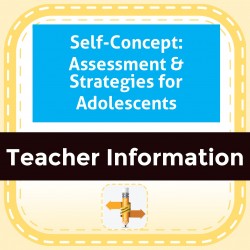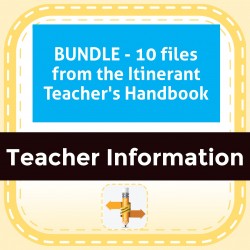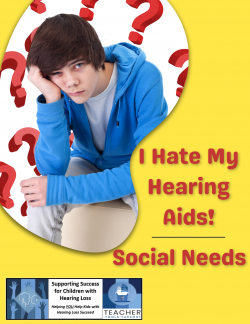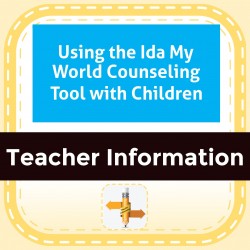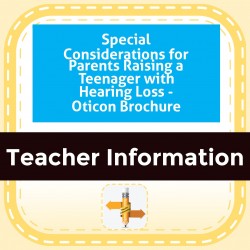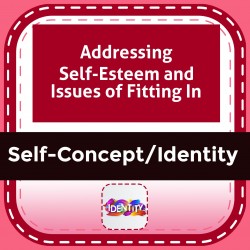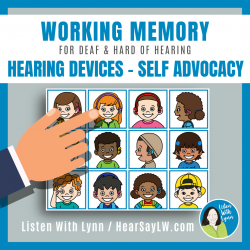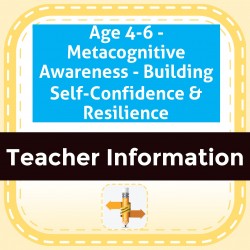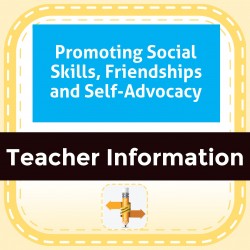Ability Levels
Categories
Resource Types
Age/Grade Range
CCSS
Anchor Standard
Speaking & Listening
Language
Reading
Self-Concept: Assessment & Strategies for Adolescents
$ 0
Describes self-concept in adolescents, suggests ways to assess, and strategies to help adolescents improve their level of self-concept.
BUNDLE - 10 files from the Itinerant Teacher's Handbook
$ 2595
This bundle includes 10 files from The Itinerant Teacher's Handbook: 1) Potential Impact of Hearing Loss, 2) Collaborative Relationships, 3) Life Balance, 4) Collaborative Teamwork, 5) Making Inclusio
...
n Work, 6) Promoting Language and Literacy, 7) Helping Parents Communicate, 8) Promoting Social Skills, Friendships, Self-Advocacy, 9) Assessment Issues, 10) Planning Transitions. Save 33% over purchasing all 10 separately. NOTE: Printed book is available for $59. P05TEA0426-435)
Social Needs & "I hate my hearing aids!"
$ 0
Informational handout reviewing the challenges hearing loss poses to a child's peer acceptance. Peer acceptance also impacts resistance to wearing hearing aids. Responding to hearing aid wear issues i
...
s addressed and some suggestions for intervention.
Using the Ida My World Counseling Tool with Children
$ 0
Chart listing ages 2-3 years, 4-6 years, 7-11 years, 12-19 years with characteristics of communication, stage of PS-ychosocial development, goal, activity, and additional resources/supports.
Special Considerations for Parents Raising a Teenager with Hearing Loss - Oticon Brochure
$ 0
Informational handout by Oticon for families of teenagers with hearing loss. Includes strategies for supporting hearing aid use in teens who are resisting use.
Article: Social-Emotional Development in Children with Hearing Loss
$ 0
Thesis provides a comprehensive review of social emotional development and children with hearing loss. 2014
Addressing Self-Esteem and Issues of Fitting In
$ 0
Information handout on the importance of self-esteem to school success, PS-ychosocial development, and strategies to help feelings of fitting in to the mainstream classroom.
Hearing Devices - Self Advocacy Working Memory
$ 2
If you have students who are deaf and hard of hearing that need help with auditory working memory, executive functioning, and following directions, this Listening Finger Walk is a must-have! It builds
...
lds vocabulary about types of hearing loss and hearing devices. It boosts confidence and helps children feel good about their own hearing technology. It's fun for the kids and a simple no-prep resource for you. Just open the PDF on your screen or print it and go!The colorful playing board features 16 children wearing hearing devices like hearing aids, cochlear implants, and bone-anchored hearing systems. You can target vocabulary like unilateral, bilateral, behind-the-ear, in-the-ear, earmolds, processor, headpiece, magnet, coil, microphone, and more.This Listening Finger Walk:➼ helps build listening skills and working memory by allowing kids to work with auditory information without losing track of what they're doing.➼ targets vocabulary, descriptive skills, spoken language, and communication skills.➼ has three rounds that each increase in auditory complexity.Includes:✧ A Hearing technology or devices theme for therapy sessions or school lessons✧ Listening and Spoken Language Tips✧ Print Version: Easy print and go!✧ Digital Version No Prep Ready to screen sharePlease Note: This activity and the Positive Self-Concept Auditory Learning Games contain similar images of the same children. The resources both target self-advocacy but have different auditory and language-based goals. You will want both resources you will want in your Summer Toolbox.◈ ◈ ◈ ◈ ◈ ◈ ◈ ◈ ◈ ◈ ◈ ◈ ◈ ◈ ◈ ◈ ◈ ◈ ◈ ◈ ◈ ◈ ◈ ◈ ◈ ◈ ◈ ◈ ◈ ◈ CUSTOMER TIPS:➼ Questions? EMAIL ME before purchasing this resource or anytime later♥ ♥ ♥ Sign-up HERE for the Listen With Lynn Emails♥ Let’s Connect:InstagramFacebookKeep up your excellent work. I am blessed to help along the way.Thanks so much!Lynn Wood
Age 4-6 - Metacognitive Awareness - Building Self-Confidence & Resilience
$ 6
For ages 4-6 years: This information addresses students recognizing that they have a hearing loss, understanding feelings, learning expected class listening behaviors, remembering what was heard via s
...
ubvocalization skills, responding to teasing, making friends. The purpose of this book is to raise awareness for the reasons why hearing device rejection happens and specific instruction to occur at different ages to build student resilience and self-confidence, thereby increasing the likelihood that they will not reject using their hearing technology. Specific teaching activities and recommendations for instructional materials to develop identified skills have been included in this Guide.
Promoting Social Skills, Friendships and Self-Advocacy
$ 395
This information describes strategies for promoting social skills, friendships and self-advocacy for school-age students who are deaf or hard of hearing. This includes general strategies for teaching
...
social skills, problem-solving, self-advocacy and how to help students deal with stress and academic independence.
 Your browser is out of date. For best experience switch to latest updated Browser.
Your browser is out of date. For best experience switch to latest updated Browser.
 Get Chrome
Get Chrome Get Edge
Get Edge Get Firefox
Get Firefox